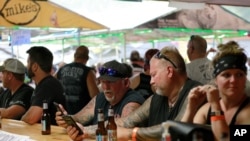A wedding reception in Maine led to nearly 160 COVID-19 cases. A motorcycle rally in South Dakota spread the coronavirus to more than 230 people and perhaps as many as 250,000, according to one estimate. Meanwhile, house parties and bar nights in college towns across the country are sparking outbreaks that make public health officials wince.
A few events are triggering a rash of coronavirus infections. These "superspreader" events seem to be on the rise, public health experts say. They worry that these events will seed outbreaks that ultimately reverse the overall downward trend in COVID-19 cases and deaths as summer winds down, temperatures cool and entertainment increasingly moves indoors.
It is concerning, but not surprising, to see these superspreading events happening more often, said Michael Mina, an epidemiologist at the Harvard T.H. Chan School of Public Health.
"Short of enacting martial law or something, we were always going to see people start to move back and try to create some sense of normalcy in their life again," he said. "I just wish we had been able to get the virus under control beforehand, before people got to this point where they just don't care anymore."
The Maine event
For reasons that are not entirely understood, a small number of cases result in a disproportionate amount of infections. These people are the so-called superspreaders.
About 65 celebrants attended a wedding reception at the Big Moose Inn in Millinocket, Maine, on August 7.
The inn was over capacity, and guests were not wearing masks, according to the state health inspector.
One month later, three people are dead of COVID-19, and nearly 160 cases have been traced to the event.
Notably, none of the three fatalities attended the reception themselves. All contracted the coronavirus secondhand.
It is a "perfect reminder of what can happen where there is a long-duration (indoor) event with a high number of individuals where mask-wearing was not the norm," Nirav Shah, Maine Centers for Disease Control and Prevention director, said at a news conference Tuesday.
That is also why public health officials consider the Sturgis motorcycle rally, an annual event since 1938, a potential worst-case scenario.
Nearly half a million bikers rolled into the South Dakota town in early August, packing bars, tattoo parlors and concert venues. Images from the event show coronavirus precautions being widely ignored.
News reports, have traced at least 236 cases in 10 states to the rally. A study using cellphone data and mathematical modeling puts the estimate at more than 260,000, incurring more than $12 billion in health care costs.
People and places
Superspreading is not unique to COVID-19. In the 2015 Middle East Respiratory Syndrome (MERS) outbreak in South Korea, five patients spread the disease to 154 people, while 186 patients infected no one else. Five patients infected 144 others in the 2003 outbreak of Severe Acute Respiratory Syndrome (SARS).
In fact, epidemiologists in the late 1990s found that respiratory ailments, sexually transmitted infections, vector-borne parasites and other diseases all follow what they call the 20/80 rule: 20% of the cases are responsible for 80% of disease transmission. Those figures might be more like 10/80 for COVID-19, according to one recent study.
Both a person and a place contribute to a superspreading event.
It is not clear why, but "some people simply shed more of the virus or bacteria than other people do," said Vanderbilt University infectious disease expert William Schaffner.
A weakened immune system or a more severe case may mean a patient will carry and shed more virus for longer.
A person's behavior also can affect how much they will spread the virus. The fact that people can be infected with no symptoms means they can be spreading the virus without knowing it.
"That's the very reason we all have to wear masks," Schaffner said.
The carrier's social life is a factor, too. All else being equal, a hermit will infect fewer people than a socialite. That’s how social distancing works, too.
While experts still have a lot of questions about what makes a person a superspreader, Schaffner noted, "as far as places go, we do know pretty well."
Prolonged exposure in confined indoor spaces with limited ventilation clearly is problematic, as some of the earliest case studies showed. At a restaurant in Guangzhou, China, in January, one patient infected nine others along the flow of the air conditioning. At a call center in South Korea in February, more than 40% of the workers on one floor were infected, nearly all of them on one side of the building.
Shouting, loud talking or singing seems to release more virus-containing particles than simply breathing. One infected person spread the virus to 52 others at a choir practice in Washington state in March.
That is why bars and parties worry health officials. Confined indoor spaces with lots of people packed together talking loudly are perfect settings for superspreader events.
That is why two Los Angeles TikTok stars had their power cut in August and face charges for house parties that violated the city's coronavirus emergency orders.
With schools back in session, The New York Times reports more than 100 college towns are seeing increases in coronavirus cases, as students head to bars and parties.
While case counts and deaths generally have been trending down in the United States, they still average around 40,000 cases per day, according to the Centers for Disease Control and Prevention. Most experts expect infections to rise again as the weather cools.
"If we go into this fall with 40,000 cases a day,” Harvard's Mina said, “we run the risk of having uncontrollable outbreaks.”








